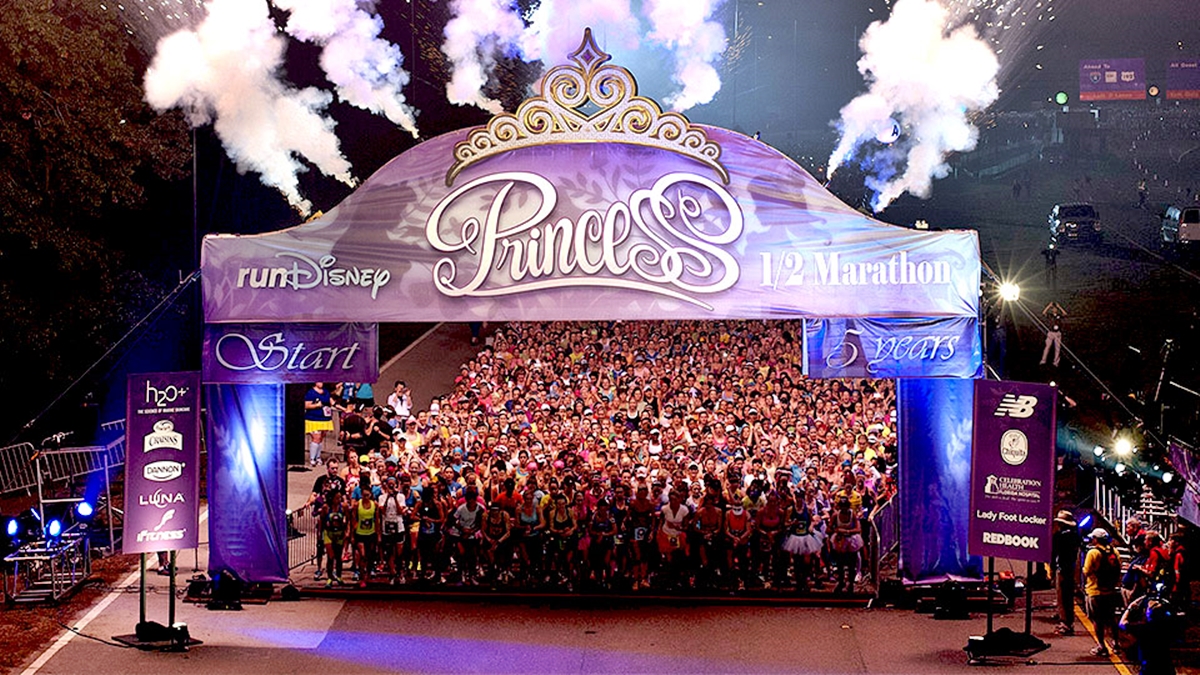Home>Misc>Featured>How To Train For A Half Marathon In 3 Months


Featured
How To Train For A Half Marathon In 3 Months
Modified: January 22, 2024
Featured: Discover the best training tips and strategies to prepare for a half marathon in just 3 months. Achieve your running goals with our expert guidance.
Introduction
Training for a half marathon is an exciting and rewarding challenge that requires dedication, discipline, and proper planning. Whether you’re a seasoned runner looking to tackle a new distance or a beginner aiming to achieve a major fitness milestone, this comprehensive 3-month training guide will help you reach your goals.
Preparing for a half marathon requires more than just lacing up your running shoes and hitting the pavement. It involves a systematic approach to gradually increase your mileage, improve your endurance, and enhance your overall fitness level. By following a structured training plan, you can minimize the risk of injury and optimize your performance on race day.
Before diving into the training details, it’s essential to understand your reasons for embarking on this journey. Are you aiming to set a personal record, raise money for a charity, or simply prove to yourself that you’re capable of conquering this distance? Identifying your goals will provide the motivation and focus needed to stay committed throughout the training process.
In this comprehensive training guide, we will provide you with a week-by-week breakdown of the essential training components, such as building your base, increasing endurance, incorporating speed and strength training, and fine-tuning your preparation. We will also touch upon important factors like nutrition, hydration, and mental preparation, which play a vital role in your overall performance.
Remember, everyone’s journey is unique, and it’s crucial to listen to your body and make adjustments when necessary. This training plan should serve as a blueprint for your success, but feel free to modify it based on your individual needs and preferences.
So, lace up your running shoes, get ready to sweat, and embark on this incredible 3-month journey to conquer the half marathon distance.
Setting Your Goals
Before you embark on your half marathon training journey, it’s important to set clear and realistic goals. By defining your goals, you can create a focused training plan tailored specifically to your needs and aspirations. Here are a few key considerations when setting your half marathon goals:
- Choose a Specific Goal: Determine what you want to achieve in your half marathon. Do you want to finish the race within a certain time frame, beat a personal best, or simply complete the distance? Having a clear and specific goal will help you stay motivated throughout the training process.
- Consider Your Current Fitness Level: Assess your current fitness level to set realistic expectations. If you are new to running or have been away from it for a while, aim for a finishing time that aligns with your current capabilities. As you progress through your training, you can reassess and adjust your goals accordingly.
- Establish Short-term and Long-term Goals: Break your training journey into smaller milestones. Setting short-term goals, such as completing specific training runs or achieving certain distances, will help you stay motivated and track your progress. Additionally, establish long-term goals for your half marathon, providing an overarching target to work towards.
- Consider External Factors: Take into account any external factors that may impact your training, such as work commitments or personal obligations. While it’s important to prioritize your training, being realistic about your time constraints will ensure that you can design a training plan that fits with your lifestyle.
- Account for Mental and Emotional Goals: Running a half marathon is not just about physical fitness—it also presents an opportunity for personal growth and mental resilience. Consider setting goals related to your mental strength, such as staying positive during difficult training runs or overcoming self-doubt on race day.
By setting meaningful and attainable goals, you’ll have a clear purpose and direction throughout your half marathon training. Remember, goals can be adjusted and modified as you progress and gain more experience. Embrace the process and enjoy the journey as you work towards achieving your goals.
Creating a Training Plan
A well-structured and personalized training plan is essential for successful preparation and injury prevention when training for a half marathon. Here are the key steps to create an effective training plan:
- Assess Your Current Fitness Level: Before you begin building your training plan, evaluate your current fitness level. Take into account your running experience, average weekly mileage, and the length of time you have before the race. Understanding your starting point will help you design a plan that is challenging yet realistic.
- Determine Your Target Weekly Mileage: Decide on the weekly mileage you aim to achieve during your training. This will depend on your goals, time availability, and current fitness level. Gradually increase your mileage during the first few weeks to build a solid base before incorporating more intense workouts.
- Incorporate Rest Days: Rest days are crucial for recovery and injury prevention. Plan for at least one or two rest days per week to allow your body to recover and adapt to the training. On these days, you can engage in low-impact activities like stretching, yoga, or foam rolling to aid in recovery.
- Include Different Types of Runs: A well-rounded training plan includes a variety of running workouts. Incorporate long runs to build endurance, tempo runs to improve your overall pace, and speed workouts to enhance your speed and anaerobic fitness. Additionally, include easy runs to promote recovery and active rest.
- Gradual Progression: Avoid sudden increases in mileage or intensity, as they can lead to overuse injuries. Gradually increase your mileage, incorporate speed or hill workouts, and add cross-training activities like cycling or swimming to improve your overall fitness without overwhelming your body.
- Listen to Your Body: Pay attention to your body’s signals during training. If you experience persistent pain or feel overly fatigued, adjust your training schedule accordingly. It’s important to find a balance between pushing yourself and allowing for adequate rest and recovery.
- Track and Evaluate: Keep a training log to document each run, noting your distance, time, perceived effort, and any observations. Regularly assess your progress and make adjustments as needed. This will help you identify patterns, evaluate your strengths and weaknesses, and make informed decisions about your future training.
Remember, the key to creating a successful training plan is consistency and adaptability. Be prepared to make adjustments along the way based on your body’s response and changing circumstances. With a well-structured training plan, you’ll be on the right track to achieving your half marathon goals.
Week 1: Building Your Base
During the first week of your half marathon training, the focus is on laying a solid foundation by building your base mileage. This week sets the stage for your future training and helps condition your body for the upcoming challenges. Here’s what your training plan for Week 1 might look like:
- Day 1: Easy Run (3-4 miles): Start the week with an easy-paced run to get your body moving. Focus on maintaining a comfortable pace that allows for conversation. This run helps you acclimate to training and kickstarts your cardiovascular system.
- Day 2: Strength Training or Cross-training: Dedicate this day to strength training or cross-training to work on your overall fitness and muscular strength. Engage in exercises that target your lower body, core, and upper body. Alternatively, you can cross-train by cycling, swimming, or attending a fitness class.
- Day 3: Rest Day: Allow your body to recover and rejuvenate. Rest days are crucial for avoiding burnout and reducing the risk of injury. Use this day to focus on stretching, foam rolling, or engaging in relaxation techniques.
- Day 4: Tempo Run (3 miles): Tempo runs help improve your running efficiency and increase your lactate threshold. Begin with a warm-up jog, then maintain a comfortably hard pace for 2-3 miles. Finish with a cool-down jog to recover.
- Day 5: Easy Run (3-4 miles): Similar to Day 1, go for an easy-paced run that allows you to maintain a comfortable conversation. Focus on running with good form and enjoying the process.
- Day 6: Long Run (5-6 miles): End the week with a longer run to build endurance. Start at a manageable pace and gradually increase your distance over the course of the run. Don’t be too concerned about speed; the primary focus is to cover the mileage comfortably.
- Day 7: Rest Day: Take a complete rest day to allow your body to recover from the week’s training. Use this time to reflect on your progress, set goals for the upcoming week, and prepare mentally for the challenges ahead.
During Week 1, it’s important to listen to your body and adjust the pace and distance as needed. Focus on developing a consistent training routine and establishing good habits. Remember to hydrate properly, fuel your body with nutritious foods, and prioritize rest to optimize your recovery.
By completing Week 1 of your training plan, you’ve taken the first step towards achieving your half marathon goal. Stay committed, trust the process, and get ready for the upcoming weeks of training.
Week 2: Increasing Endurance
In the second week of your half marathon training, the focus shifts to increasing your endurance. This week is crucial for building the stamina necessary to handle longer distances and maintain a steady pace. Here’s a breakdown of what your training plan for Week 2 might look like:
- Day 1: Easy Run (3-4 miles): Begin the week with an easy-paced run to warm up your muscles and get into the running groove. Focus on maintaining a comfortable pace and paying attention to your form and breathing.
- Day 2: Strength Training or Cross-training: Dedicate this day to strength training or cross-training to enhance your overall fitness. Engage in exercises that target your leg muscles, core, and upper body. Alternatively, you can opt for cross-training activities like cycling or swimming.
- Day 3: Rest Day: Allow your body to recover after a couple of days of training. Rest is essential for your muscles to repair and adapt to the increased demands of your training.
- Day 4: Hill Repeats (3-4 miles): Find a hill with a gradual incline and repeat hill intervals. Run uphill at an increased effort for about 60-90 seconds, then recover with an easy jog downhill. Repeat the cycle for a total of 4-6 hill repeats. Hill repeats help build strength and improve your running economy.
- Day 5: Easy Run (3-4 miles): Similar to Day 1, go for an easy-paced run to maintain your momentum and allow for active recovery. Focus on maintaining a comfortable pace and enjoying the run.
- Day 6: Long Run (7-8 miles): This week’s long run is longer than the previous week, helping you build endurance. Start at a comfortable pace and aim to cover 7-8 miles. Remember to pace yourself and listen to your body, taking walk breaks if needed.
- Day 7: Rest Day: Take a complete rest day to give your body time to recover and recharge. Use this day to stretch, foam roll, or engage in other recovery techniques to aid in your overall recovery process.
Remember to hydrate adequately throughout the week and fuel your body with nutritious foods to support your training. Additionally, proper rest and recovery are crucial for allowing your body to adapt and build endurance.
By completing Week 2 of your training plan, you’re progressing steadily towards your half marathon goal. Keep up the consistency, listen to your body, and embrace the challenges of increasing your endurance.
Week 3: Adding Speed Training
In the third week of your half marathon training, it’s time to incorporate speed training to improve your running efficiency and overall race pace. Speed workouts help develop your anaerobic capacity, increase your stride turnover, and enhance your overall running performance. Here’s how you can structure your training plan for Week 3:
- Day 1: Easy Run (3-4 miles): Begin the week with an easy-paced run to warm up your muscles and prepare for the upcoming speed workouts. Focus on maintaining a comfortable pace and paying attention to your running form.
- Day 2: Strength Training or Cross-training: Dedicate this day to strength training or cross-training to complement your running workouts. Engage in exercises that target your lower body, core, and upper body. Alternatively, you can opt for cross-training activities like swimming or cycling to work different muscle groups and improve your overall fitness.
- Day 3: Rest Day: Allow your body to recover and recharge. Rest is essential for muscle repair and growth, enabling you to perform at your best during your training.
- Day 4: Interval Training (3-4 miles): Incorporate interval training to improve your speed and racing performance. Start with a warm-up jog, then run at a faster pace for a set distance or time (e.g., 800 meters or 2 minutes). Take a recovery jog or walk for a set time (e.g., 1-2 minutes), then repeat the cycle for a total of 4-6 intervals. Finish with a cool-down jog to recover.
- Day 5: Easy Run (3-4 miles): Similar to Day 1, go for an easy-paced run to promote recovery and maintain your running routine. Focus on maintaining a comfortable pace and enjoying the process.
- Day 6: Long Run (8-9 miles): Increase your long run distance this week to further build your endurance. Aim to cover 8-9 miles at a steady and comfortable pace. Remember to listen to your body, hydrate adequately, and take walk breaks if needed.
- Day 7: Rest Day: Take a complete rest day to allow your body to recover from the week’s training. Use this time to stretch, foam roll, or engage in other recovery techniques to aid in your overall recovery process.
It’s important to note that speed workouts can put additional strain on your muscles and joints. Listen to your body and adjust the intensity or duration of the intervals as needed. Prioritize proper warm-up and cool-down routines to reduce the risk of injury and enhance your overall performance.
By incorporating speed training into your half marathon training plan, you’re taking significant steps towards improving your race pace and overall running performance. Embrace the challenge, stay consistent, and keep pushing yourself to reach new heights.
Week 4: Incorporating Strength Training
In the fourth week of your half marathon training, it’s time to introduce strength training to your routine. Strength training plays a crucial role in improving your running performance, reducing the risk of injury, and enhancing overall muscular strength and endurance. Here’s how you can structure your training plan for Week 4:
- Day 1: Easy Run (3-4 miles): Begin the week with an easy-paced run to warm up your muscles and prepare for the upcoming strength workouts. Focus on maintaining a comfortable pace and paying attention to your running form.
- Day 2: Strength Training: Dedicate this day to strength training, focusing on exercises that target your lower body, core, and upper body. Include exercises like squats, lunges, deadlifts, planks, and push-ups to develop overall strength and stability. Aim for 2-3 sets of 8-12 repetitions for each exercise.
- Day 3: Rest Day: Allow your body to recover and recharge. Rest is crucial for muscle repair and growth, enabling you to perform at your best during your training.
- Day 4: Tempo Run (4-5 miles): Incorporate a tempo run to improve your race pace and lactate threshold. Start with a warm-up jog, then maintain a comfortably hard pace for 2-3 miles. Finish with a cool-down jog to recover.
- Day 5: Easy Run (3-4 miles): Similar to Day 1, go for an easy-paced run to promote recovery and maintain your running routine. Focus on maintaining a comfortable pace and enjoying the process.
- Day 6: Long Run (9-10 miles): Increase your long run distance this week to further build your endurance. Aim to cover 9-10 miles at a steady and comfortable pace. Remember to listen to your body, hydrate adequately, and take walk breaks if needed.
- Day 7: Rest Day: Take a complete rest day to allow your body to recover from the week’s training. Use this time to stretch, foam roll, or engage in other recovery techniques to aid in your overall recovery process.
Strength training is a valuable component of your half marathon training as it helps improve your running form, reduce muscle imbalances, and enhance your overall performance. Incorporating strength exercises into your routine 2-3 times per week will yield long-term benefits, so be consistent and gradually increase the intensity and difficulty of your workouts over time.
Remember to prioritize proper form and technique for each exercise to maximize effectiveness and reduce the risk of injury. Consult with a fitness professional if you’re unsure about proper execution or need guidance on selecting appropriate exercises.
By incorporating strength training into your half marathon training plan, you’re taking a proactive approach to improve your overall fitness and performance. Stay dedicated, focused, and continue to challenge yourself as you progress towards your half marathon goal.
Week 5: Focusing on Tempo Runs
In the fifth week of your half marathon training, the focus shifts towards tempo runs, a key workout that helps improve your race pace and overall running efficiency. Tempo runs help you develop your lactate threshold, allowing you to sustain a faster pace for longer durations. Here’s how you can structure your training plan for Week 5:
- Day 1: Easy Run (3-4 miles): Begin the week with an easy-paced run to warm up your muscles and prepare for the upcoming tempo runs. Focus on maintaining a comfortable and conversational pace.
- Day 2: Strength Training: Dedicate this day to strength training, focusing on exercises that target your lower body, core, and upper body. Include exercises like squats, lunges, planks, and push-ups to build strength and stability. Aim for 2-3 sets of 8-12 repetitions for each exercise.
- Day 3: Rest Day: Allow your body to recover and rejuvenate. Rest is essential for muscle repair and growth, helping you perform at your best during your training.
- Day 4: Tempo Run (4-5 miles): Incorporate a tempo run to focus on your race pace. Start with a warm-up jog, then increase your pace to a comfortably hard effort for 3-4 miles. Finish with a cool-down jog to recover.
- Day 5: Easy Run (3-4 miles): Similar to Day 1, go for an easy-paced run to promote recovery and maintain your running routine. Prioritize maintaining good running form and enjoying the process.
- Day 6: Long Run (10-11 miles): Increase your long run distance to further build your endurance. Aim to cover 10-11 miles at a steady and comfortable pace. Remember to listen to your body, take walk breaks if needed, and stay hydrated throughout the run.
- Day 7: Rest Day: Take a complete rest day to allow your body to recover from the week’s training. Use this time to stretch, foam roll, or engage in other recovery techniques to support your overall recovery process.
During the tempo run, focus on maintaining a comfortably hard pace that challenges you but still allows you to sustain the effort. Proper pacing is key, so start conservatively and gradually increase your pace with each tempo run. Consistency and progression are important to see improvements in your race pace over time.
Keep in mind that rest and recovery are just as valuable as the training itself. Prioritize proper rest, nutrition, and hydration to optimize your performance and reduce the risk of injury.
By incorporating tempo runs into your training plan, you’re honing your ability to sustain a faster pace, improving your race performance, and increasing your overall running efficiency. Stay consistent, trust the process, and continue to challenge yourself as you progress towards your half marathon goal.
Week 6: Endurance Building Phase
As you enter the sixth week of your half marathon training, it’s time to focus on the endurance building phase. This phase involves gradually increasing your mileage and building your aerobic capacity, preparing your body to handle the demands of the half marathon distance. Here’s how you can structure your training plan for Week 6:
- Day 1: Easy Run (4-5 miles): Begin the week with an easy-paced run to warm up your muscles and prepare for the upcoming workouts. Focus on maintaining a comfortable and conversational pace.
- Day 2: Strength Training: Dedicate this day to strength training, focusing on exercises that target your lower body, core, and upper body. Include exercises like squats, lunges, deadlifts, planks, and push-ups to develop overall strength and stability. Aim for 2-3 sets of 8-12 repetitions for each exercise.
- Day 3: Rest Day: Allow your body to recover and recharge. Rest is crucial for muscle repair and growth, enabling you to perform at your best during your training.
- Day 4: Intervals (3-4 miles): Incorporate interval training to improve your speed and anaerobic capacity. Run at a faster pace for a set distance or time (e.g., 400 meters or 2 minutes), followed by a recovery jog or walk. Repeat the cycle for a total of 4-6 intervals. Finish with a cool-down jog.
- Day 5: Easy Run (4-5 miles): Similar to Day 1, go for an easy-paced run to promote recovery and maintain your running routine. Enjoy the run and focus on your breathing and running form.
- Day 6: Long Run (11-12 miles): Increase your long run distance to further build your endurance. Aim to cover 11-12 miles at a steady and comfortable pace. Remember to pace yourself, fuel properly, and hydrate adequately throughout the run.
- Day 7: Rest Day: Take a complete rest day to allow your body to recover from the week’s training. Utilize this time for gentle stretching, foam rolling, or engaging in other recovery techniques to support your overall recovery process.
The endurance building phase is crucial for gradually increasing your mileage and getting your body accustomed to running for extended periods. It’s important to listen to your body and adjust your pace and distance as needed.
During the long run, focus on maintaining a comfortably challenging pace and practicing proper fueling and hydration strategies. This will help you simulate race day conditions and build the mental and physical resilience necessary for the half marathon distance.
Remember, consistency and patience are key during the endurance building phase. Stay committed, trust the process, and embrace the challenges as you progress towards your half marathon goal.
Week 7: Fine-tuning Your Training
As you approach week 7 of your half marathon training, it’s time to shift your focus towards fine-tuning your training to optimize your performance on race day. This week is about refining your running form, improving your pacing strategy, and incorporating specific workouts to target areas of improvement. Here’s how you can structure your training plan for Week 7:
- Day 1: Easy Run (4-5 miles): Begin the week with an easy-paced run to warm up your muscles and prepare for the upcoming workouts. Focus on maintaining a comfortable and conversational pace.
- Day 2: Strides: Incorporate strides into your run. After an easy run, do a few sets of 20-30 second sprints at near maximum speed, focusing on good running form. Allow sufficient recovery between strides.
- Day 3: Rest Day: Allow your body to recover and recharge. Rest is crucial for muscle repair and growth, enabling you to perform at your best during your training.
- Day 4: Fartlek Training (3-4 miles): Fartlek, meaning “speed play” in Swedish, involves incorporating random bursts of speed into your run. After a warm-up jog, pick random landmarks ahead and increase your pace to a faster effort until you reach each landmark. Ease back to an easy pace for recovery. Repeat this cycle for the duration of your run.
- Day 5: Easy Run (4-5 miles): Similar to Day 1, go for an easy-paced run to promote recovery and maintain your running routine. Focus on consistent pacing and good running form.
- Day 6: Long Run (13-14 miles): Increase your long run distance to continue building endurance. Aim to cover 13-14 miles at a steady and comfortable pace. Emphasize proper hydration, fueling, and maintaining good running form throughout the run.
- Day 7: Rest Day: Take a complete rest day to allow your body to recover from the week’s training. Use this time for light stretching, foam rolling, or engaging in other recovery techniques to support your overall recovery process.
During Week 7, pay close attention to your running form, focusing on posture, arm movements, and foot strike. Practice proper breathing techniques to optimize your oxygen intake. Additionally, work on mental focus and concentration during your runs to enhance your race-day mindset.
As you fine-tune your training, consider your pacing strategy. Practice running at your goal race pace during specific workouts to familiarize your body with the effort required. This will help you establish a comfortable and sustainable pace on race day.
Remember, the goal in Week 7 is to refine and sharpen your training. Stay disciplined, maintain consistent effort, and trust the progress you’ve made so far. The half marathon is just within reach, and you’re well on your way to achieving your goal.
Week 8: Incorporating Hill Training
As you enter Week 8 of your half marathon training, it’s time to incorporate hill training into your routine. Hill workouts provide numerous benefits such as improved strength, increased speed, and enhanced running efficiency. By challenging yourself on inclines, you’ll be better prepared to tackle varied terrain during the race. Here’s how you can structure your training plan for Week 8:
- Day 1: Easy Run (4-5 miles): Begin the week with an easy-paced run to warm up your muscles and ensure proper recovery. Focus on maintaining a comfortable and conversational pace.
- Day 2: Hill Repeats: Incorporate hill repeats into your training to build strength and improve cardiovascular fitness. Find a moderate hill with a gradual incline. Run uphill at a challenging effort for about 60-90 seconds, focusing on maintaining good form. Recover with a slow jog or walk downhill. Repeat the cycle for a total of 4-6 hill repeats.
- Day 3: Rest Day: Allow your body to recover and rejuvenate. Rest is essential for muscle repair and growth, enabling you to perform at your best during your training.
- Day 4: Tempo Run (6-7 miles): Focus on maintaining a comfortably hard pace for a sustained period. Begin with a warm-up jog, then increase your pace to a challenging effort for 4-5 miles. Finish with a cool-down jog to recover.
- Day 5: Easy Run (4-5 miles): Similar to Day 1, go for an easy-paced run to promote recovery and maintain your running routine. Focus on maintaining a comfortable pace and enjoying the run.
- Day 6: Long Run (15-16 miles): Increase your long run distance to further build endurance. Aim to cover 15-16 miles at a steady and comfortable pace. Incorporate elevation changes if possible, simulating race day conditions.
- Day 7: Rest Day: Take a complete rest day to allow your body to recover from the week’s training. Use this time to stretch, foam roll, or engage in other recovery techniques to support your overall recovery process.
During hill workouts, focus on maintaining good running form, taking shorter strides, and engaging your core and glutes. Embrace the challenge of running uphill, and remember to recover adequately on the downhill portions.
By incorporating hill training into your routine, you’ll improve your overall running strength and efficiency, making you better equipped to handle race day conditions. Stay committed, stay consistent, and embrace the uphill battles as you progress towards your half marathon goal.
Week 9: Tapering and Recovery
As you approach the final week of your half marathon training, it’s time to taper and prioritize recovery. Tapering allows your body to fully recover, while also maintaining your fitness levels for peak performance on race day. Here’s how you can structure your training plan for Week 9:
- Day 1: Easy Run (3-4 miles): Begin the week with an easy-paced run to warm up your muscles and promote blood flow. Focus on maintaining a comfortable pace and avoiding any high-intensity efforts.
- Day 2: Taper Workout: Incorporate a shorter, higher-intensity workout to maintain your fitness while minimizing stress on your body. This could be a short tempo run or a series of faster intervals. Keep the overall volume and intensity lower than your regular training sessions.
- Day 3: Rest Day: Allow your body to recover and rejuvenate. Rest is crucial for muscle repair and growth, enabling you to perform at your best on race day.
- Day 4: Easy Run (3-4 miles): Similar to Day 1, go for an easy-paced run to keep your legs moving and maintain a sense of routine. Focus on maintaining a relaxed pace and enjoying the run.
- Day 5: Rest Day: Take a complete rest day to allow your body to recover from the week’s training. Use this time to engage in light stretching, foam rolling, or other relaxation techniques that promote recovery.
- Day 6: Short Easy Run (2-3 miles): Go for a short and easy-paced run to maintain a sense of familiarity and keep your muscles engaged. Focus on keeping the effort level low and enjoying the run.
- Day 7: Rest Day: Take a complete rest day to ensure maximum recovery and conserve energy for race day. Use this time to relax, visualize your race, and focus on positive mental preparedness.
During the taper week, it’s important to prioritize recovery. Maintain a balanced diet, stay hydrated, and get plenty of sleep to optimize your body’s ability to repair and rebuild. Avoid any new or strenuous activities that may increase the risk of injury or fatigue.
Remember, the taper period allows your body to fully recover and be in peak condition for race day. Trust your training, have faith in your abilities, and approach race day with a calm and focused mindset. You’ve put in the hard work, and now it’s time to reap the rewards of your dedication.
Week 10: Mental Preparation
In the final week leading up to your half marathon, your focus should shift towards mental preparation to ensure you have a strong mindset on race day. While physical training is essential, your mental state can greatly impact your performance. Here’s how you can structure your training plan for Week 10:
- Day 1: Easy Run (2-3 miles): Begin the week with a short and easy-paced run to warm up your body and clear your mind. Focus on enjoying the run and focusing on positive thoughts.
- Day 2: Visualization and Mentally Rehearsing: Spend time visualizing yourself successfully completing the half marathon. Envision yourself crossing the finish line, feeling strong and accomplished. Mentally rehearse your race-day strategies, such as pacing, handling discomfort, and maintaining a positive mindset.
- Day 3: Rest Day: Allow your body and mind to recover and recharge. Rest is crucial for conserving energy and ensuring you’re mentally fresh for race day.
- Day 4: Short Easy Run (1-2 miles): Go for a short and easy-paced run to maintain a sense of familiarity and keep your muscles engaged. Focus on calming your mind and reasserting your race goals.
- Day 5: Rest Day: Take another complete rest day to ensure maximum recovery and mental relaxation. Use this time to engage in activities that help you relax and promote positive thinking.
- Day 6: Packet Pickup and Race Prep: Attend the race packet pickup to get your bib number, timing chip, and any necessary race instructions. Lay out your race-day gear, plan your nutrition and hydration strategy, and double-check that you have everything you need for a successful race.
- Day 7: Rest and Mental Readiness: Take a complete rest day to conserve energy and mentally prepare for the race. Visualize yourself performing well, staying strong when challenges arise, and maintaining a positive attitude throughout the race. Trust in your training and believe in your ability to achieve your goals.
Mental preparation involves developing a positive mindset, managing pre-race nerves, and embracing the excitement of race day. Remind yourself of all the hard work and dedication you’ve put into training and trust in your abilities. Use positive affirmations, relaxations techniques, and visualizations to stay focused and calm.
Remember, the mind plays a significant role in your performance. By nurturing a positive and confident mindset, you will be better equipped to push through the tough moments and embrace the joy of accomplishing your half marathon goal.
Week 11: Nutrition and Hydration
In the penultimate week leading up to your half marathon, it’s crucial to pay attention to your nutrition and hydration. Proper fueling and hydration strategies can greatly impact your performance and ensure you have the energy you need on race day. Here’s how you can structure your training plan for Week 11:
- Day 1: Easy Run (2-3 miles): Begin the week with a short and easy-paced run to warm up your body. Focus on maintaining a comfortable pace and paying attention to your form and breathing.
- Day 2: Meal Planning: Create a meal plan for the week leading up to the race. Focus on consuming a balanced diet rich in carbohydrates, lean proteins, healthy fats, and plenty of fruits and vegetables. Include foods that you are familiar with and that work well with your digestive system.
- Day 3: Rest Day: Allow your body and mind to recover and recharge. Rest is crucial for conserving energy and allowing your body to absorb and utilize the nutrients from your food.
- Day 4: Pre-Race Nutrition: Familiarize yourself with pre-race nutrition strategies. Plan your pre-race meal and practice it during a training run to ensure it sits well with you. Focus on consuming easily digestible carbohydrates and hydrating adequately leading up to the race.
- Day 5: Easy Run (2-3 miles): Similar to Day 1, go for a short and easy-paced run to maintain a sense of familiarity and keep your muscles engaged. Focus on maintaining good running form and enjoying the run.
- Day 6: Hydration Awareness: Pay attention to hydration throughout the week. Aim to drink water regularly and maintain proper hydration levels. Develop a hydration plan for race day, including how and when you will consume fluids during the race.
- Day 7: Rest Day: Take a complete rest day to allow your body to recover and prepare for race day. Use this time to relax, visualize a successful race, and mentally prepare for the challenges and excitement ahead.
During Week 11, focus on nourishing your body with nutrient-dense foods that support your training and recovery. Ensure you consume enough carbohydrates to fuel your muscles, lean proteins to aid in muscle repair, and healthy fats for overall energy and satiety.
On race day, stick to your predetermined nutrition plan. Start the race well-hydrated and consume fluids regularly along the course. Practice your fueling strategy during long runs to ensure it suits your needs and avoids any potential digestive issues.
Remember, nutrition and hydration are crucial aspects of your half marathon performance. By prioritizing proper fueling and hydration, you’ll have the energy and stamina you need to achieve your race day goals.
Week 12: Final Preparations
As you enter the final week before your half marathon, it’s time for the last-minute preparations to ensure you’re ready for race day. This week is all about fine-tuning, staying focused, and taking care of your body. Here’s how you can structure your training plan for Week 12:
- Day 1: Easy Run (2-3 miles): Begin the week with a short and easy-paced run to warm up your body. Focus on maintaining a comfortable and relaxed pace, allowing your muscles to loosen up.
- Day 2: Race Route Familiarization: Study the half marathon course map and familiarize yourself with any elevation changes, landmarks, or potential challenging sections. Mentally prepare for these parts to ensure you have a game plan on race day.
- Day 3: Rest Day: Allow your body and mind to recover and recharge. Rest is crucial for conserving energy and ensuring you’re mentally fresh for the race.
- Day 4: Short Easy Run (1-2 miles): Go for a short and easy-paced run to keep your muscles engaged and maintain a sense of familiarity. Focus on staying relaxed and mentally preparing for the upcoming race.
- Day 5: Gear Check and Race-Day Outfit: Lay out all the race-day gear you’ll be wearing, including shoes, socks, apparel, and accessories. Ensure each item is comfortable, broken-in, and suitable for the expected weather conditions.
- Day 6: Mental Preparation and Visualization: Spend time visualizing yourself successfully completing the half marathon. Envision crossing the finish line, feeling strong and accomplished. Mentally rehearse your positive self-talk, focusing on perseverance and overcoming any challenges.
- Day 7: Rest and Relaxation: Take a complete rest day to allow your body to recover and conserve energy for race day. Engage in activities that help you relax and decompress, such as gentle stretching, foam rolling, or a relaxing bath.
During Week 12, it’s important to dial back the intensity and volume of your training, allowing your body to fully recover and be at its peak for race day. Focus on maintaining a positive mindset, staying relaxed, and trusting your training.
Additionally, pay attention to sleep, hydration, and nutrition during the final week. Aim for quality sleep to ensure adequate rest and recovery. Stay hydrated throughout the week, and pay attention to your pre-race meals to fuel your body effectively.
Remember, you have put in the hard work over the past 12 weeks. Trust in your training, believe in yourself, and approach race day with confidence and excitement. You’re ready for the challenge and the thrill of crossing that finish line!
Conclusion
Congratulations! You have successfully completed 12 weeks of training, preparing yourself for the half marathon. Throughout this journey, you have built a solid foundation of endurance, strength, and mental resilience. As race day approaches, it’s important to reflect on your progress and embrace the excitement and anticipation of achieving your goal.
From the early weeks of building your base mileage to incorporating speed, strength, and hill training, you have challenged yourself and pushed your limits. You have developed the physical and mental stamina needed to take on the half marathon distance.
But it’s not just about the physical training. Your mental preparation, determination, and consistency have played a crucial role in getting you to this point. Visualizing success, focusing on positive self-talk, and engaging in relaxation techniques have kept you mentally strong throughout the training process.
As you enter the tapering phase, remember to prioritize rest, recovery, and proper nutrition. Allow your body to recover fully, and trust in the work you’ve put in during the past 12 weeks. Trust your training, listen to your body, and have confidence in your abilities.
On race day, soak in the atmosphere, and enjoy the experience. Embrace the inevitable challenges and remind yourself of all the hard work and dedication that brought you to this moment. Push yourself, but also appreciate the journey and celebrate your achievements along the way.
Remember that a half marathon is not just a race; it’s a testament to your determination, your discipline, and your ability to persevere. It’s a celebration of your physical and mental strength.
Whether you achieve a personal best, complete the distance for the first time, or simply enjoy the experience, know that you have accomplished something extraordinary. Take pride in your achievements and use them as inspiration for future goals.
Thank you for embarking on this incredible journey with us. We wish you the best of luck on race day and in all your future running endeavors. Remember, the finish line awaits, and you have the strength and determination to conquer it!









